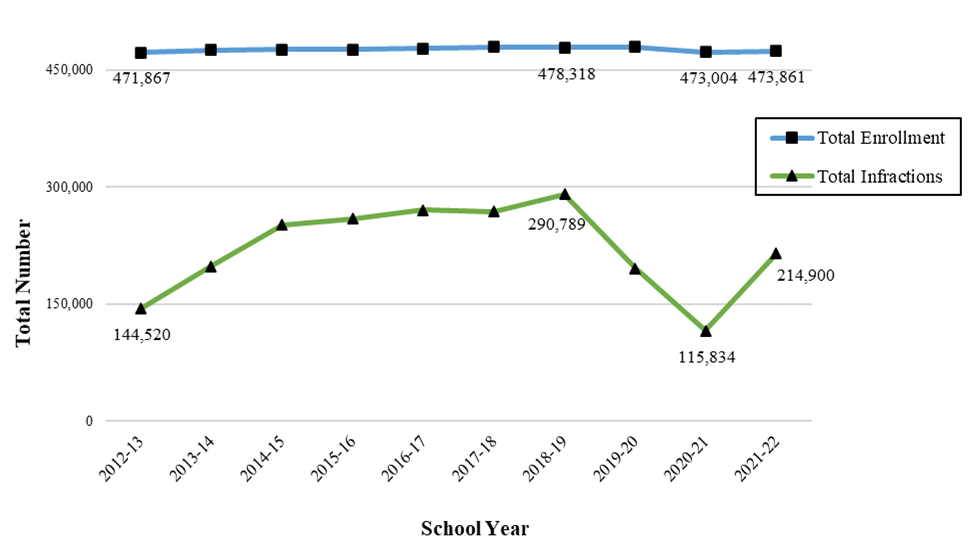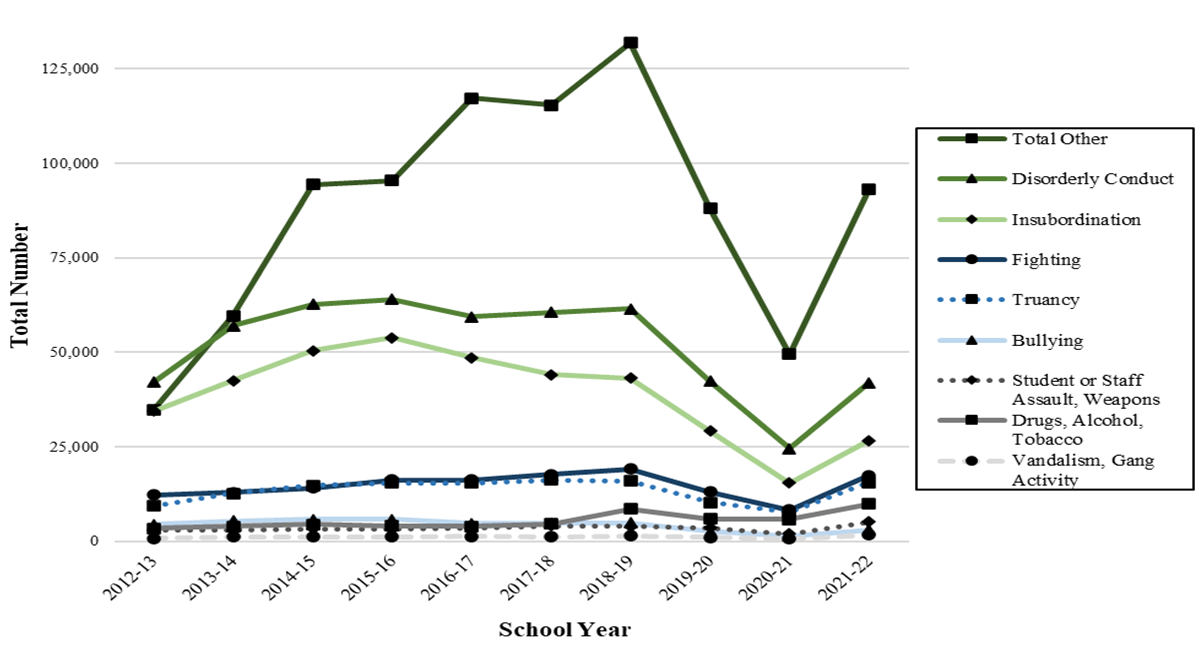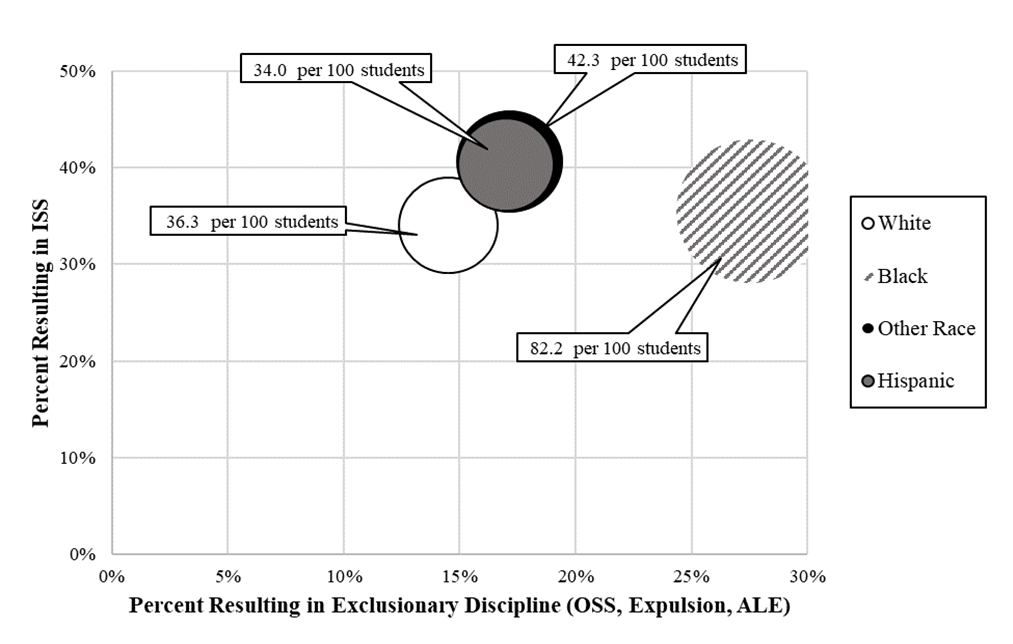Today OEP is releasing the findings from the 2022 Arkansas Student Discipline Report. We identify trends in key student outcomes related to student discipline in the Arkansas public schools, and examine how recent policy changes to disciple are working to reduce exclusionary discipline for students. We recommend reading the full report or the shorter policy brief, but we wanted to share the highlights of what we found.
More Referrals: Following consecutive declines during 2019-20 and 2020-21, the number of reported disciplinary infractions rose in 2021-22. The increase likely reflects a return to “typical” school, with students back in classrooms in person full-time, and perhaps a lifting of schools’ COVID-related protocols. The number of reported infractions in 2021-22, however, has not reached to pre-pandemic trends.
Figure 1: Discipline Infraction Referrals, 2013-2022

What exactly is “Other”?: As reported in prior years, many discipline referrals and consequences are not categorized within the state-provided data and are labeled as “other”. This lack of clarity around types of discipline referrals and consequences could mask ongoing disparities between students groups that may be contributing to negative student outcomes.
Figure 2: Discipline Infraction Referrals by Category, 2013-2022

More Out-of-School Suspensions: The use of Out-of-School Suspension as a consequence increased in 2021-22 to the highest level since 2013-14. In 2021-22, OSS was used as a consequence for 19% of disciplinary infractions. The use of OSS as a consequence for behavior infractions steadily declined over the past decade, but the recent increase indicates that schools in Arkansas are returning to the use exclusionary approaches. The recent increase of OSS infractions is concerning, because students who receive OSS are excluded from the opportunity to access instruction at school.
Figure 3: Discipline Consequences by Type, 2013-2022

Disproportionalities persist: Disproportionalities by race/ethnicity, free and reduced-price lunch eligibility, and special education status continue to exist both in terms of the number of referrals for infractions, the types of infractions referred, and in the likelihood of receiving exclusionary discipline conditional on referral for a particular type of infraction.
Figure 4 shows that in 2021-22, Black students received 82.2 infractions per 100 students, compared to 34 to 42 referrals per 100 students of other racial groups. Not only are Black students in the state much more likely to be referred for disciplinary infractions, but they also are more likely to receive exclusionary discipline as a result. In 2021-22, 27.5% of all infractions for Black students resulted in exclusionary discipline, relative to 14.5% for White students.
Figure 4: Discipline Disproportionalities by Race, 2021-22

Little OSS for Truancy: The use of Out-of-School Suspension as a consequence for truancy declined from about 14% of all truancy cases in 2012-13 to about 2% of cases in 2021-22. The state of Arkansas has made excellent progress with Act 1329 compliance. There are, however, a small set of 21 schools that continue to use OSS as a consequence for truancy to some extent.
Still OSS for K-5 Students: The use of Out-of-School Suspension as a consequence for students in grades K-5 have declined, from 17% of consequences in 2016-17 to 15% in 2021-22. This decrease reflect the intention line of Act 1059 of 2017, which limited the use of exclusionary discipline for students in kindergarten through fifth grade to extreme cases where there is a physical risk to the student or others, or which cannot be addressed through other means. A large proportion of elementary-aged suspensions, however, are for relatively subjective categories such as disorderly conduct, insubordination, and “other.” This suggests that there is still room for improvement in terms of limiting suspensions to extreme cases and providing more consistent opportunities for K-5 students to access learning opportunities in school.
Figure 5: K-5 Exclusionary Discipline, 2013-22

While the percentage of suspensions and expulsions used as a consequence for K-5 students decreased somewhat over time, Black students in grades K-5 were still 4.0 times as likely as White students to receive at least one OSS or expulsion in 2021-22. This is lower than the relative risk ratio prior to Act 1059 (4.7 to 4.8 times) but is still troublingly high and persistent. Previous research indicated that the discrepancy in exclusionary discipline was between schools, not within the same school (Anderson and Ritter, 2017)
Over 80% of discipline referrals reported over the past ten years are for insubordination, disorderly conduct, or “other” infractions. These infractions are relatively subjective, and large racial disproportionalities are evident.
Based off of our findings from this analysis of student discipline in Arkasnas, we suggest:
- “Other” categories for infractions and consequences should be assessed to determine whether the infraction reporting categories reflect the current needs of the state and what the “other” consequences really are. School personnel should be included in the evaluation of current and additional discipline referral and consequence reporting categories.
- Targeted interventions for schools to address the racial disproportionalities evident in the data.
- A deeper dive into how schools are addressing behavioral issues, mental health issues, and school climate issues more broadly.
